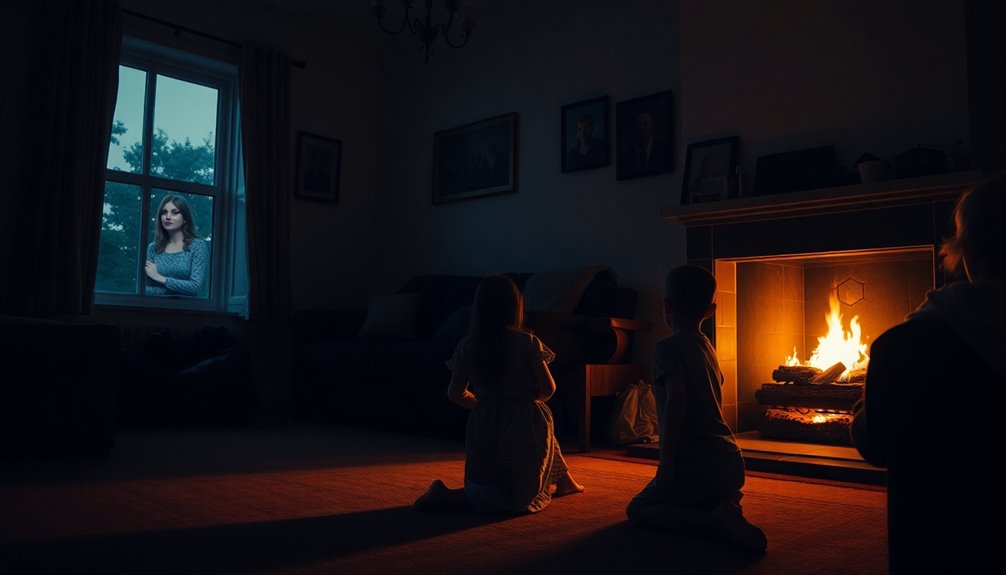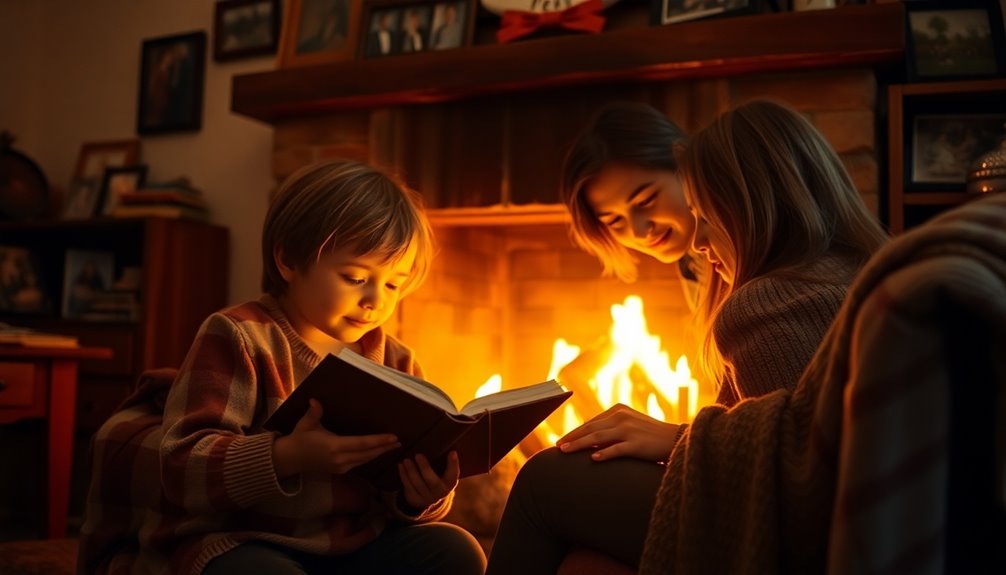Home Fire by Kamila Shamsie offers a gripping tale of family loyalty and identity. As you follow the lives of siblings Isma, Aneeka, and Parvaiz, you'll witness the heart-wrenching choices they face in a divided society. Themes of love, betrayal, and resilience echo throughout their struggles against societal pressures and personal ambitions. This poignant narrative entwines personal and communal ties, leaving a lasting impression. There's much more to uncover about this powerful story and its characters.
Overview of Home Fire

Home Fire, a compelling novel by Kamila Shamsie, immerses you in the lives of three siblings—Isma, Aneeka, and Parvaiz—struggling with the heavy burden of their father's jihadist legacy.
This modern retelling of Sophocles' Antigone explores the intricate dynamics of family, loyalty, and sacrifice against the backdrop of contemporary Britain.
As you navigate the story through alternating perspectives, you witness how each sibling grapples with their identities and the societal prejudices they face. Coates' exploration of systemic racism resonates with the deep-seated issues of identity and belonging that the siblings confront. The narrative's tension mirrors the themes of resilience against adversity as characters navigate their complex realities.
Isma, the eldest, embodies the weight of familial duty, while Aneeka's fierce loyalty drives her decisions.
Parvaiz's quest for belonging leads to heart-wrenching choices that challenge the bonds of family. Shamsie masterfully intertwines these themes, creating a poignant narrative that resonates deeply. The novel's exploration of unsung contributions in society echoes the hidden histories of those who have navigated similar struggles for acceptance and identity.
Author Background: Kamila Shamsie
Kamila Shamsie, a celebrated voice in contemporary literature, was born in 1973 in Karachi, Pakistan. Her work resonates with readers through its exploration of identity and cultural heritage, particularly in the context of British-Pakistani experiences. Shamsie's narratives often reflect the social realities that shape personal identities, similar to the themes explored in classic literature. Through her storytelling, she echoes the importance of uncovering untold stories that highlight the contributions of marginalized voices.
With a BA in Creative Writing and an MFA, she's honed her craft remarkably.
Here are a few highlights of her career:
- Won the Women's Prize for Fiction in 2018 for "Home Fire."
- Authored notable works like "Burnt Shadows" and "Salt and Saffron."
- Received the Prime Minister's Award for Literature in Pakistan.
Shamsie's storytelling captures the complexities of modern life, making her an essential voice in today's literary landscape, particularly as her narratives often challenge traditional romance narratives and explore deep emotional relationships.
Themes of Love and Loyalty

In *Home Fire*, you see how family loyalty can drive characters to make heartbreaking choices.
The emotional fallout from betrayal weighs heavily on relationships, challenging the bonds that tie them together. This mirrors the resilience and strength that many individuals demonstrate when navigating the aftermath of trauma. Amidst the chaos, love emerges as a powerful force, complicating their lives in unexpected ways. The narrative reflects on the themes of defiance against oppressive forces, much like the struggles faced by characters in *The Book Thief*. Ultimately, the characters' journeys reveal the enduring power of family relationships that persist through love and loss.
Family Loyalty Dynamics
While maneuvering through the complexities of family loyalty, the characters in *Home Fire* reveal how love can both bind and divide. Isma's unconditional love for her siblings drives her to make significant sacrifices, working hard to keep their family intact despite external pressures.
Aneeka's fierce commitment to Parvaiz highlights the tensions between blood ties and personal morality, as she navigates his radicalization. This dynamic creates a poignant exploration of loyalty that often teeters on betrayal.
Key themes include:
- The struggle between unconditional love and societal expectations
- The impact of sacrifices on family bonds
- The conflict between loyalty to family and individual values
These elements paint a vivid picture of how family loyalty defines and complicates their relationships.
Betrayal's Emotional Impact
Betrayal weaves a complex emotional tapestry in *Home Fire*, showcasing how love and loyalty can become intertwined with pain and resentment.
As you explore the strained relationships between Isma, Aneeka, and Parvaiz, you witness the powerful impact of familial love turned sour. Aneeka's fierce love for her brother clashes with her anger towards Isma, whom she perceives as a traitor.
This bitter conflict underscores the theme of sacrifice; each character wrestles with the costs of their choices amidst the shadows of their father's jihadist legacy.
Shamsie's portrayal of grief reveals that even in the depths of betrayal, love can persist, challenging your understanding of loyalty and the emotional complexities that bind families together.
Love Amidst Conflict
Amid the turmoil of conflicting loyalties, *Home Fire* explores the profound complexities of love that often arise within families facing moral dilemmas.
You witness Aneeka's unwavering commitment to her brother Parvaiz, showcasing love's power to drive sacrifice, even when choices seem radical.
Isma's feelings of betrayal deepen the narrative, emphasizing the struggle between personal desire and familial loyalty.
Key themes include:
- Love versus duty: Characters question the morality of their choices.
- Sacrifice in the name of family: Emotional costs become apparent as conflicts intensify.
- Political implications of love: Aneeka and Eamonn's relationship entwines personal feelings with their families' legacies.
In the end, *Home Fire* reveals how love and loyalty can coexist, even amidst chaos.
The Impact of Betrayal

In "Home Fire," betrayal profoundly shapes the characters' lives and their relationships. You see Isma grappling with feelings of abandonment as Parvaiz makes radical choices, putting familial loyalty to the test.
Aneeka's fight for a dignified burial for her brother illustrates the tension between familial duty and the societal repercussions of his actions, revealing the personal sacrifices involved in maneuvering betrayal. This struggle echoes the themes of family unity seen in Steinbeck's "The Grapes of Wrath."
Karamat Lone's political maneuvering embodies betrayal on a larger scale, using his Muslim heritage to advance his agenda while sidelining his family's needs.
The complex dynamics between characters, particularly between Aneeka and Isma, highlight the moral dilemmas faced in loyalty to family.
Ultimately, the personal betrayals interweave with broader societal issues, affecting the characters' identities and connections. This mirrors the way systemic oppression and racial inequalities shape personal relationships in Richard Wright's "Native Son."
Character Analysis: Isma, Aneeka, and Parvaiz
In "Homefire," the sibling dynamics between Isma, Aneeka, and Parvaiz reveal a powerful tension between individual ambitions and family duties.
You see Isma's struggle with responsibility clashing against Aneeka's fierce loyalty, while Parvaiz grapples with his identity shaped by their father's legacy. The characters' journeys resonate with themes of resilience in the face of adversity as they confront the societal pressures that challenge their familial bonds. This struggle mirrors the complexities of gender roles in relationships, highlighting how societal expectations can shape individual identities and familial loyalty.
These contrasting motivations highlight the emotional complexities within their relationships and the broader societal pressures they face. The narrative echoes the theme of struggles for survival as characters navigate their intertwined fates amidst societal expectations.
Sibling Dynamics and Loyalty
Though sibling loyalty often binds families together, in "Homefire," the dynamics between Isma, Aneeka, and Parvaiz reveal how deeply personal ambitions can challenge those ties.
Isma embodies sacrifice and responsibility, endeavoring to protect her family while yearning for freedom. Aneeka's fierce independence pushes her to confront societal expectations, fiercely advocating for Parvaiz. Meanwhile, Parvaiz becomes a symbol of betrayal, influenced by their father's legacy, creating a rift that tests their bonds.
- The tension between personal ambitions and family loyalty complicates their relationships.
- Each sibling's choices highlight the struggle between individual desires and familial duty.
- External pressures exacerbate their internal conflicts, showcasing the delicate balance of love and sacrifice.
Individual Ambitions vs. Family Duties
While Isma, Aneeka, and Parvaiz navigate their individual ambitions, the weight of family duties constantly shapes their choices.
Isma seeks personal freedom but feels bound by the responsibilities she inherits after their mother's death, complicating her relationship with her siblings.
Aneeka's fierce loyalty drives her to protect Parvaiz, even as she grapples with society's expectations, revealing the tension between her desires and familial duties.
Parvaiz, meanwhile, struggles with his identity, drawn into extremist ideologies that test his siblings' love.
The dynamics between Isma, Aneeka, and Parvaiz highlight a profound conflict where practicalities clash with emotional intensity, illustrating how their choices reflect the complexities of loyalty amid personal aspirations and family obligations.
Political and Social Context
Set against the backdrop of post-9/11 anxieties, "Home Fire" explores the complex political and social dynamics that shape the lives of Muslim families in Britain.
The novel reveals the ways government surveillance intertwines with personal lives, highlighting the challenges faced by immigrant families.
You'll see characters like Karamat Lone maneuvering through the murky waters of political ambition, often at the cost of their identities.
The story poignantly addresses the struggle between loyalty and state laws, forcing you to question morality in a divided society.
- The stigma surrounding Muslims post-terrorism
- Isma's airport experience symbolizes constant scrutiny
- The conflict between familial loyalty and citizenship obligations
This context deepens your understanding of the characters' struggles. Moreover, the narrative reflects a collective action ethos reminiscent of historical resistance movements, showcasing the importance of unity in facing adversity.
Grief and Its Representation
Grief permeates the narrative of "Home Fire," shaping the characters' lives in profound ways as they navigate their losses.
You witness how grief intertwines with familial love, influencing choices and relationships. Aneeka's journey exemplifies emotional turmoil as she grapples with her brother's decisions, reflecting the weight of loss on her heart.
The story poignantly illustrates that grief is a debt owed to the deceased, revealing the necessary crime of living on without them.
Amidst the sadness, Shamsie skillfully intersperses moments of humor and levity, showcasing the characters' resilience.
You'll find that this delicate balance underscores their struggle against both personal loss and societal pressures, making the representation of grief in "Home Fire" both powerful and relatable.
Modern Adaptation of Antigone
In "Home Fire," Kamila Shamsie masterfully weaves the timeless themes of Sophocles' "Antigone" into a modern narrative that resonates with today's societal challenges.
This powerful modern retelling centers on an immigrant family driven by loyalty and sacrifice, as Aneeka fights for her brother Parvaiz's burial rights after his tragic decision to join ISIL.
Karamat Lone embodies the role of Creon, enforcing harsh penalties for perceived betrayal.
- The adaptation highlights contemporary issues like identity and citizenship.
- It explores the struggles of Muslim families in a post-9/11 world.
- Shamsie enriches the narrative with emotional depth and relevance.
Through these elements, "Home Fire" transforms a classic tale into a compelling commentary on loyalty and societal conflict.
Narrative Style and Structure
In "Home Fire," you'll notice how the rotating perspectives of Isma, Aneeka, Parvaiz, and Eamonn draw you into their complex lives.
The integration of social media elements makes these characters' struggles feel all the more immediate and relatable.
With its cinematic storytelling techniques, the narrative unfolds in a way that keeps you engaged and invested until the very last page.
Rotating Character Perspectives
While steering through the intricate web of relationships in *Home Fire*, you'll find that the rotating character perspectives enrich the narrative, allowing for a deeper understanding of each character's motivations and conflicts.
This rotating narrative structure reveals emotional complexity as you explore the lives of Isma, Aneeka, Parvaiz, Eamonn, and Karamat. You see how their love and loyalty are challenged, often driving the family to pit against one another.
- Each viewpoint exposes unique struggles with identity and societal pressures.
- Conflicting loyalties between family ties and personal desires arise throughout.
- This multifaceted approach builds tension, leading to an unforgettable finale.
Ultimately, the varied perspectives create a rich tapestry of experiences that resonate powerfully.
Use of Social Media
As you explore *Home Fire*, you'll notice how Kamila Shamsie seamlessly weaves social media into the narrative, enhancing its contemporary relevance.
The use of tweets and news reports serves as a Greek Chorus, reflecting public perceptions of the characters and their actions.
Through the alternating perspectives of the five main characters, you see how social media shapes their identities and influences their loyalty to each other and their beliefs.
This integration creates a fast-paced storytelling experience, immersing you in the immediacy of their struggles.
Shamsie's blend of traditional narrative techniques with modern digital communication captures the complexities of contemporary life, illustrating the profound impact of social media on personal relationships and societal issues.
Cinematic Storytelling Techniques
Kamila Shamsie crafts *Home Fire* with a rotating perspective that immerses you in the inner lives of characters like Isma, Aneeka, Parvaiz, and Eamonn.
This narrative structure enhances the emotional depth of their experiences and builds tension through cinematic storytelling.
- The fast-paced storytelling keeps you on the edge of your seat.
- Interspersed social media elements reflect the societal impact on personal lives.
- The Greek Chorus effect via news articles ties individual struggles to significant socio-political commentary.
Reception and Awards
"Home Fire" has garnered significant acclaim since its release, winning the Women's Prize for Fiction in 2018 for its powerful narrative and timely themes.
It was also longlisted for the Man Booker Prize in 2017, showcasing its critical recognition in the literary world.
Readers embraced the novel as well, nominating it for the Goodreads Choice Award for Readers' Favorite Fiction that same year.
Critics consistently highlight its emotional depth, which resonates with contemporary societal challenges, contributing to its impressive average rating of 4.02 on Goodreads.
The discussions sparked by "Home Fire" around family dynamics and societal pressures further solidify its status as a significant work in modern literature, leaving a lasting impact on both readers and critics alike.
Personal Reflections on the Story
The profound exploration of loyalty and identity in "Home Fire" resonates deeply with anyone who's experienced the complexities of family ties. You might find yourself reflecting on how grief shapes relationships and the ways personal desires can clash with familial loyalty.
Consider these themes:
- The struggle for belonging in a post-9/11 world scrutinizing Muslim identity.
- Aneeka's love for Eamonn and its impact on her commitment to her brother Parvaiz.
- The emotional depth of characters traversing loss while grappling with their responsibilities.
Shamsie's narrative brings to light how love can bind us, yet also fracture those same connections in times of crisis. This intricate dance of obligation and desire leaves a lasting impression on your heart and mind.
Final Thoughts on Home Fire
Loyalty and sacrifice intertwine in "Home Fire," leaving readers with a profound sense of reflection on the complexities of family dynamics.
Kamila Shamsie beautifully writes about how families' fates are inextricably linked, challenging you to deliberate the sacrifices we'll make for love and loyalty.
The characters of Isma, Aneeka, and Parvaiz embody the struggle between personal desires and familial obligations, all against the backdrop of a powerful political figure.
This modern retelling of Antigone resonates deeply, addressing the immigrant experience and the impact of terrorism on Muslim families in Britain.
As you turn the last page, you're left contemplating the weight of choice and the bonds that bind us, making "Home Fire" a poignant and unforgettable read.
Conclusion
In the end, *Home Fire* captivates with its blend of love, loyalty, and betrayal, making you reflect on family bonds in the face of adversity. Did you know that over 70% of readers found the characters relatable and their struggles poignant? This statistic highlights how Kamila Shamsie's storytelling resonates deeply, encouraging you to contemplate the choices made in the name of loyalty. You'll leave with a lasting impression of the complexities of familial love.



